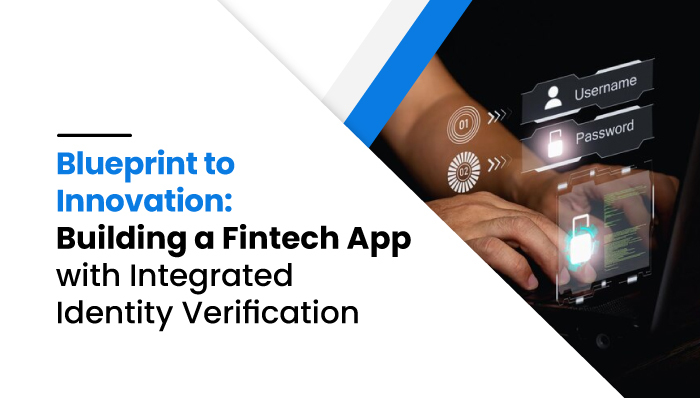Blueprint to Innovation: Building a Fintech App with Integrated Identity Verification

Blueprint to Innovation: Building a Fintech App with Integrated Identity Verification
In the dynamic world of technology, fintech apps are redefining the boundaries of financial transactions. These digital platforms merge convenience with security, delivering seamless user experiences. For budding entrepreneurs and developers aiming to tap into this lucrative domain, understanding the fundamentals of building a fintech app, with a focus on integrated identity verification, is essential. This article provides a comprehensive guide on creating a fintech app, ensuring it’s fortified against the prevalent cyber threats.
Identifying the Niche
-
Market Research:
- Start with thorough market research. Identify the gaps in the current fintech landscape, analyze competitors, and gauge user demands. This will help in carving out a niche for your app and addressing specific user needs.
-
Target Audience:
- Define your target audience. Understanding their preferences, behavior, and financial needs is crucial for tailoring the features and functionalities of your app.
Designing the User Experience
-
User Interface:
- A user-friendly interface is vital. Ensure the design is intuitive, with easy navigation and clear CTAs. Prioritize simplicity and clarity to enhance user engagement.
-
User Journey:
- Map out the user journey meticulously. Every step, from onboarding to transaction completion, should be seamless, fostering user satisfaction and retention.
Core Features and Functionalities
-
Transactions & Payments:
- Incorporate diverse transaction and payment options, catering to the varied needs of users. Ensure smooth money transfers, bill payments, and investment transactions.
-
Notifications & Alerts:
- Implement real-time notifications and alerts to keep users informed about transaction statuses, account updates, and promotional offers.
-
Customer Support:
- Provide robust customer support through chatbots, FAQs, and contact forms, ensuring timely assistance and resolution of user queries.
Integrating Identity Verification
-
Importance:
- Integrating id verification is non-negotiable. It safeguards against fraud, enhances user trust, and ensures regulatory compliance.
-
Technology Selection:
- Choose the right identity verification technology. Options include biometrics, AI-driven analytics, and blockchain for secure data storage.
-
User Authentication:
- Implement multi-factor authentication, combining passwords, security tokens, and biometrics, to fortify app security.
Regulatory Compliance and Security
-
Data Protection:
- Adhere to data protection regulations such as GDPR and HIPAA. Implement encryption and secure data storage to safeguard user information.
-
Security Protocols:
- Integrate advanced security protocols such as SSL and TLS. Regularly update security measures to combat evolving cyber threats.
Developing the App
-
Tech Stack:
- Select the appropriate tech stack, considering factors like scalability, performance, and security. Popular choices include React Native, Node.js, and MongoDB.
-
Development Methodology:
- Choose a development methodology that aligns with your project requirements. Agile and Scrum are widely adopted for their flexibility and efficiency.
Testing and Quality Assurance
-
Testing Phases:
- Conduct rigorous testing through various phases, including unit testing, integration testing, and user acceptance testing, to ensure app reliability.
-
Feedback and Iteration:
- Collect user feedback and iterate the app accordingly. Address any bugs, improve functionalities, and enhance the overall user experience.
Launching the App
-
Market Strategy:
- Develop a comprehensive marketing strategy, leveraging social media, content marketing, and SEO, to boost app visibility and user acquisition.
-
App Store Optimization:
- Optimize your app listing on app stores with compelling descriptions, visuals, and keywords to enhance discoverability and downloads.
Post-Launch Support and Updates
-
Customer Feedback:
- Continuously gather customer feedback post-launch. Address any issues promptly and incorporate user suggestions to improve the app.
-
Regular Updates:
- Roll out regular updates with new features, security enhancements, and performance improvements to keep the app relevant and secure.
Conclusion
Building a fintech app is a journey of innovation and resilience. By focusing on user experience, integrating advanced identity verification, and ensuring compliance and security, developers can create a fintech app that stands out in the competitive market. Continuous improvement and adaptation to emerging technologies are key to maintaining the app’s relevance and safeguarding it against the ever-evolving landscape of cyber threats. With the right approach and dedication, a fintech app can transform the financial ecosystem, delivering convenience and security to users across the globe.



 WhatsApp Spy
WhatsApp Spy Facebook & Messenger Spy
Facebook & Messenger Spy Viber Spy
Viber Spy Instagram Spy
Instagram Spy Skype Spy
Skype Spy TikTok Spy
TikTok Spy Telegram Spy
Telegram Spy LinkedIn Spy
LinkedIn Spy Twitter Spy
Twitter Spy Youtube Spy
Youtube Spy Photo Spy
Photo Spy Video Spy
Video Spy Calls and Contacts Tracking
Calls and Contacts Tracking SMS & IM Chats
SMS & IM Chats Voice Capture
Voice Capture Image Capture
Image Capture Video Record
Video Record